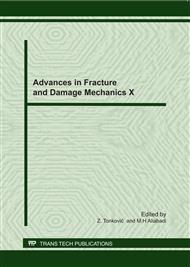p.662
p.666
p.670
p.674
p.678
p.682
p.686
p.690
p.694
Explosion and Temperature Resistance of Underground Structures by Free Hexagons
Abstract:
It appears that sudden change of loading such as shock wave impinging on underground structures, which is mostly linked up with an extreme increase of temperature, causes immense disasters, which involve loss of human lives, heavy machine damage, long-lasting traffic troubles, decreasing of bearing capacity of the structural system, etc. A combination of shock wave due to both the elevated temperature accompanying explosion leads to cracking of the bearing system of underground openings, for example to cracking of concrete lining, i.e. to reduction of thickness of the bearing structures, etc. It has been previously proved that the free hexagon method serves for identifying the damage in the bearing system of underground structures very well. The dynamical influences have to be also emerged if extreme raise of temperature and explosion are involved in this problem; formulation is briefly mentioned and the results from numerical simulations are presented. It will be shown that the superheated vapor interacting with shock and temperature waves caused by the point charge inside of the underground open space may cause extensive occurrence of fissures on the surface exposed to the external loading envisaged.
Info:
Periodical:
Pages:
678-681
Citation:
Online since:
September 2011
Authors:
Price:
Сopyright:
© 2012 Trans Tech Publications Ltd. All Rights Reserved
Share:
Citation:


